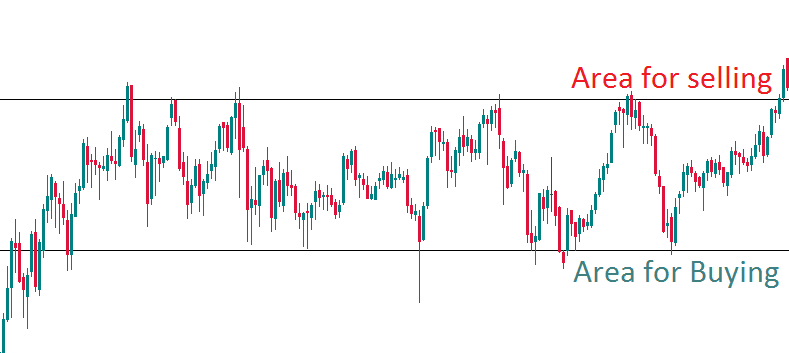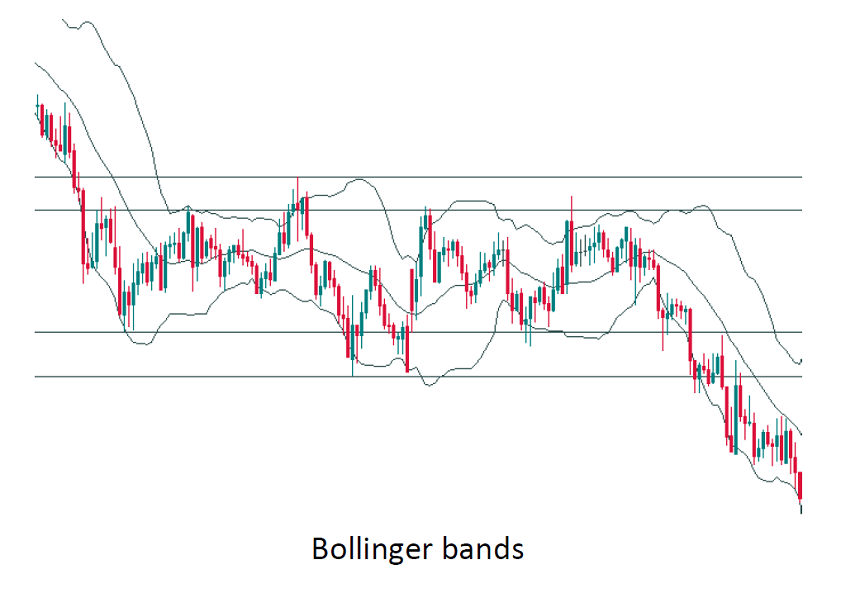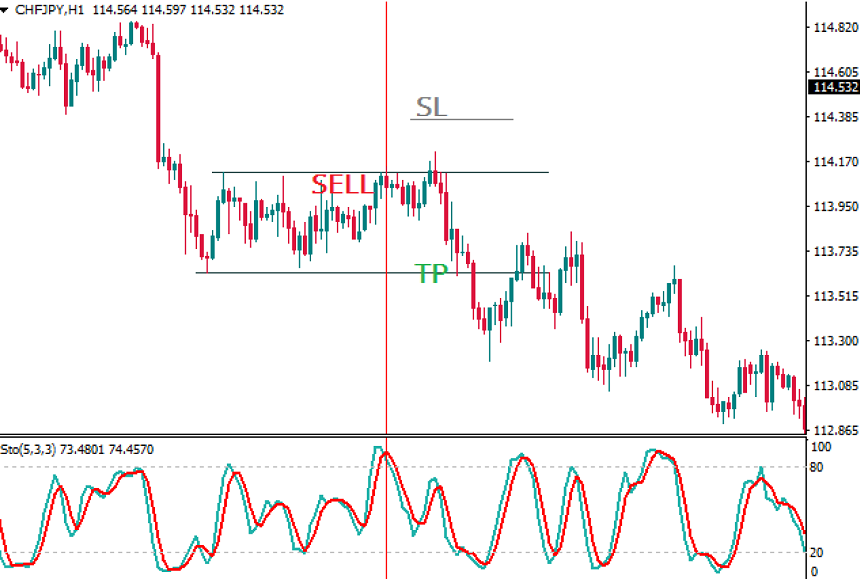Range
Informationen sind keine Investitionsberatung
Der Range-Handel findet statt, wenn der Markt keine klare Richtung hat. Weder Bullen noch Bären können einen Trend starten, und der Kurs bewegt sich seitwärts. Das Fehlen eines Aufwärtstrends oder Abwärtstrends ist jedoch kein Grund, den Handel zu unterlassen. Es ist möglich, Gewinne zu erzielen, während der Markt an eine Range gebunden ist.
Die Range-Händler zählen darauf, dass die Kurse für einige Zeit zwischen den gleichen horizontalen Niveaus handeln werden. Sie erwarten, dass sich der Kurs sowohl vom Widerstand als auch von der Unterstützung mehrfach bewegen wird. Das Ziel eines Händlers ist es, von den Kursschwankungen innerhalb der Range zu profitieren, indem er am Widerstand verkauft und an der Unterstützung kauft.

Beachten Sie, dass die wichtigsten Währungspaare (EUR/USD, GBP/USD, USD/JPY, AUD/USD, NZD/USD und USD/CAD) tendenziell stärker tendieren. Sie haben zwar Konsolidierungsperioden, sind aber dennoch weniger für den Range-Trading geeignet. Kreuzungen (EUR/GBP, CHF/JPY, AUD/CAD und GBP/JPY) verbringen mehr Zeit in Range.
Wie kann man in einer Range handeln?
Der erste Schritt für einen Range-Händler besteht darin, die Grenzen der Range zu definieren, mit anderen Worten, Unterstützung und Widerstand zu finden. Der einfachste Weg, dies zu tun, ist, die vorherigen Höchst- und Tiefstwerte des Charts zu überprüfen. Wenn die Höhen auf einer horizontalen Linie liegen und auch die Tiefen, haben Sie vielleicht den Widerstand und die Unterstützungsbereiche gefunden. Natürlich sind in Wirklichkeit die Höhen nicht genau auf der gleichen Linie positioniert und die Tiefen auch nicht. Der Markt macht jedoch keine höheren Höchst- und Tiefststände, wie sie für einen Aufwärtstrend typisch sind (oder niedrigere Höchststände und Tiefststände, die auf einen Abwärtstrend hinweisen). Bollinger-Bands können auch helfen, die Grenzen des Bereichs zu verfolgen, da sie dynamische Unterstützung und Widerstand darstellen, die ihn begrenzen.

Der zweite Schritt ist die Verfolgung von überkauften und überverkauften Zuständen des Kurses. Die Idee ist, zu verkaufen, wenn ein Währungspaar überkauft ist (am Widerstand) und zu kaufen, wenn es überverkauft wird (an der Unterstützung). Um überkaufte/überverkaufte Bedingungen zu identifizieren, verwenden Händler eine Art technischer Indikatoren "Oszillatoren". Solche Indikatoren drehen sich um eine zentrale Ebene.
Wenn ein Oszillator von einer Mittellinie aufsteigt und einen extremen Bereich auf der Oberseite erreicht, bedeutet das, dass das Paar überkauft ist. Wenn sich das Paar zu einem Zeitpunkt in der Nähe der Widerstandszone befindet, ist es Zeit zum Verkauf.Wenn ein Oszillator von einer zentralen Linie fällt und einen extremen Bereich auf der unteren Seite erreicht, bedeutet das, dass das Paar überverkauft ist. Wenn das Paar in der Nähe der Unterstützungszone ist, ist es Zeit zum Kauf.Die populärsten Oszillatoren sind RSI, CCI und Stochastik. Die Stochastik scheint am empfindlichsten auf Kursschwankungen zu reagieren.
Zusammenfassend lässt sich sagen, dass der Kurs an eine der Grenzen der Range gelangt und das Signal eines Oszillators der Auslöser für den Eintritt in einen Handel ist. Die Wahrscheinlichkeit eines erfolgreichen Geschäfts ist höher, wenn es ein Umkehr-Kerzenmuster in der Nähe des Widerstands/der Unterstützung gibt.

Risikomanagement
Es ist immer notwendig, die Handelsrisiken zu begrenzen. Das Hauptrisiko für Range-Handel besteht darin, dass die Range gebrochen wird. Eine erfolgreiche Range-Handelsstrategie besteht darin, kleine, aber beständige Gewinne zu erzielen und Verluste zu minimieren.
Der Range-Handel ist gut, wenn der Markt nicht sehr volatil ist. Daher ist es nicht empfehlenswert, in Ranges zu handeln, wenn die Volatilität steigt. Nachrichtenereignisse können den Kurs weit weg in eine Richtung verschieben. Wenn Sie also einen Range-Handel planen, überprüfen Sie den Wirtschaftskalender, um sicherzustellen, dass keine wichtigen Veröffentlichungen für die von Ihnen ausgewählten Währungen geplant sind.
Die Regeln für Take Profit und Stop Loss im Range-Handel sind sehr einfach. TP wird auf der gegenüberliegenden Seite der Range platziert, während SL auf etwa die Hälfte der Amplitude der Range eingestellt ist. Dies bietet ausreichend Platz für einen Drawdown und bewahrt gleichzeitig ein Verhältnis von 2:1 Belohnung zu Risiko. Es wird nicht empfohlen, eine Position ein- oder auszuschalten. Erstens, das Hinzufügen zu einem Handel erhöht unnötigerweise Ihre Risikoexposition. Zweitens gibt es keinen wirklichen Grund zu versuchen, das Geschäft teilweise zu schließen, da TP nicht allzu weit entfernt ist.
Fazit
Der Range-Handel hat eine einfache Logik und kann auch von Anfängern erlernt werden. Gleichzeitig ist es wichtig, darauf zu achten, dass sich der Markt, während er sich in Range befindet, in einer Situation der Unsicherheit befindet. Die Grenzen einer Range können fließend sein und es können falsche Ausbrüche auftreten. Infolgedessen erforderte diese Art des Handels ein diszipliniertes Risikomanagement.
Andere Artikel in dieser Sektion
- Fibonacci-Fan
- Fibonacci expansion
- Wie verwendet man Fibonacci-Retracements?
- Umkehrkerzenmuster
- Fortsetzungskerzenmuster
- Wie geht man mit Marktrauschen um?
- Backtest von einer Handelsstrategie
- Gator Oszillator
- Market Facilitation Index
- Awesome Oscillator
- Alligator
- Bill-Williams-Theorie
- Fraktale
- Chart-Muster
- Die Gann indikatoren
- Wie kann man Ihre eigene Handelsstrategie schaffen?
- Kerzenmuster
- Trendshandel
- Carry-Trade
- Swingtrading
- Positionshandel
- Day trading
- Scalping
- Handelsstile
- Was sind Fibonacci-Tools?
- Psychologie
- Wie man die Umkehrung des Marktes erkennt
- Japanische Kerzencharts
- Trends
- Marktbedingungen und Phasen














